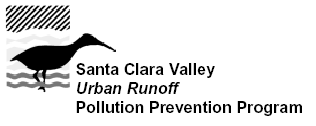Stormwater Runoff
- Vehicle Brake Pads
- Architectural Copper
- Pool/Spa/Fountain Algaecides
- Copper Pesticides
- Industrial Copper Use
- Soil Erosion
- Mobile Cleaning
- Vehicle Washing
- Vehicle Services
Discharges to POTWs
Shoreline Activities
Vehicle Services
Vehicle services (engine repair and service, fueling, vehicle body repair, replacement of fluids, recycling, cleaning, and outdoor equipment storage and parking (dripping engines)) can generate toxic hydrocarbons and other organic compounds, oils and greases, nutrients, phosphates, heavy metals, paints and other contaminants. Radiator repair and flushing operations are the most likely source of copper containing waste streams.
Stormwater Control Measures
To minimize the discharge of pollutants to the storm drain system, vehicle service activities should be conducted indoors, whenever possible with containment. If vehicles fluids must be removed outdoors, drip pans should be used to capture fluids. In addition, facility operators should use other good housekeeping measures to minimize the generation of pollutants near and within vehicle service areas. Good housekeeping measures include keeping a clean, dry shop; preventing spills and leaks; properly storing hazardous materials (in secondary containment, labeled and closed); and practicing waste reduction and recycling.
Wastewater Control Measures
Wastewaters from certain vehicle service activities may be discharged to the sanitary sewer. However, municipalities typically require permits and pretreatment and monitoring for these wastewater discharges to the sanitary sewer. The most common control measure is for municipalities to encourage or require vehicle service facilities to go to zero discharge (ceasing discharges to the sewer system). This can be accomplished by containerizing wastewaters and shipping them off-site for disposal.
Best Management Practices
Best management information sources include:
California
- CASQA - Automotive Service - Maintenance - This comprehensive fact sheet developed by the California Stormwater Quality Association provides detailed source control BMPs while conducting general maintenance and repair on vehicles.
- CASQA - Vehicle and Equipment Repair - This comprehensive fact sheet developed by the California Stormwater Quality Association provides detailed procedures for preventing or reducing the discharge of pollutants to stormwater from vehicle and equipment maintenance and repair activities.
- CASQA - Vehicle and Equipment Fueling - This comprehensive fact sheet developed by the California Stormwater Quality Association provides detailed procedures for preventing spills and leaks that may occur during vehicle and equipment fueling. Successful implementation depends on effective training of employees on applicable BMPs and general pollution prevention strategies and objectives.
- CASQA - Automotive Service- Service Stations - This comprehensive fact sheet developed by the California Stormwater Quality Association provides detailed source control BMPs while dispensing fuel at service stations. In addition, it provides approaches on how to minimize the possibility of stormwater pollution from air/water supply and dumpster and trash can areas.
- CASQA - Automotive Service- Body Repair - This comprehensive fact sheet developed by the California Stormwater Quality Association provides detailed source control BMPs while conducting auto body repair and painting.
- CASQA
- Automotive Service- Auto Recycling - This comprehensive fact sheet
developed by the California Stormwater Quality Association provides
detailed source control BMPs while dismantling vehicles; and storing
and selling vehicles and vehicle parts. In addition, this fact sheet
provides potential treatment control BMPs for protecting water quality.
- Guidelines for Vehicle Service Facilities- Six-full color pamphlets produced and distributed by the San Francisco Bay Area wastewater treatment plants and stormwater management agencies discuss how vehicle service employees can protect water quality of local creeks and San Francisco Bay. The six topics include the following:
- SCVURPPP
- Keeping It All in Tune: Car Repair and Pollution Prevention -
This brochure prepared by SCVURPPP provides general information on how
residents should plan auto repair projects to protect local creeks and
San Francisco Bay.
- BMPs
for Vehicle Service Facilities - This comprehensive information
document developed by the California Coastal Commission provides detailed
source control BMPs to address the discharge of pollutants to the storm
drain from vehicle repair shops, body shops, car washes and gas stations.
Each source control BMPs is prioritized to aid the vehicle service facility
owner in selection.
- Palo
Alto RWQCP - Cars Pollute Water Too! - This brochure prepared by
the Palo Alto RWQCP provides four examples on how automobiles pollute
and steps that can be implemented to reduce stormwater pollution to
local creeks and San Francisco Bay.
- Palo Alto RWQCP - A Brief Look at Wastewater Treatment Equipment - This brochure provides a step-by-step procedure for small facilities (i.e., automotive shops, machine shops, and corporate fleets) considering the purchase of an oil-water separator or a wastewater treatment system. The installation of an on-site wastewater treatment system will reduce the level of contaminants discharged to the sanitary sewer.
Other States
- City of New Rochelle - Pollution Prevention Practices for Automotive Service and Repair Shops - This basic two-page information sheet prepared by the City of New Rochelle, New York discusses best management practices implemented by automobile service and repair shops to control pollutants discharged to storm drains.
- Rogue
Friendly Business Program for Vehicle Service Businesses - This
comprehensive manual developed by the Rogue Friendly Business Program
describes BMPs for preventing pollution from the activities common to
automotive shops and other vehicle-related businesses. The BMPs describe
how a vehicle service owner can operate their business to reduce the
amounts of pollutants that may enter storm drains and sanitary sewers.
